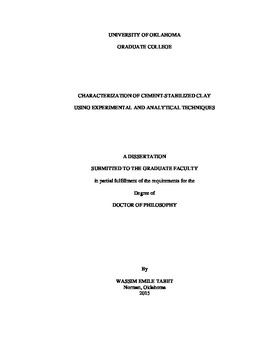| dc.description.abstract | Problematic soils such as soft, compressible, collapsible, or expansive soils are widespread throughout the world and are often becoming unavoidable due to the continuous expansion of societies. Soil improvement techniques are commonly used to enhance soil properties, increase strength and stiffness, control deformation, and reduce permeability. While soil stabilization has been implemented for many decades and the methods of application have been vastly refined, mainly empirically, an in-depth knowledge of the underlying mechanisms remains lacking.
This research study is dedicated to advancing microstructure characterization of stabilized soil and understanding the fundamental mechanisms and microstructure evolution of cement-stabilized clay in order to better understand the macroscopic behavior of the soil. A pure kaolinite was the chosen soil for this study and Portland cement was the selected stabilizer. Kaolinite samples and cement-stabilized samples were compacted at their optimum conditions and unconfined compression tests were performed to record the macroscopic behavior. An extensive set of laboratory tests including X-Ray Diffraction (XRD), Scanning Electron Microscopy (SEM), Energy Dispersive X-Ray Spectrometry (EDS), X-Ray Fluorescence (XRF), thermogravimetry (TG), and Mercury Intrusion Porosimetry (MIP), has been used to reveal the mineralogy, structure, mineral distribution, elemental composition, and pore size distribution and their corresponding changes with time due to chemical stabilization. The findings confirmed that the addition of cement resulted in the flocculation of the originally dispersed fabric accompanied by a shift from a bimodal to a unimodal pore size distribution. Cementitious products were increasingly abundant with time, mostly formed in void spaces and resulted in the partitioning of large pores into smaller pores. Calcium silicate hydrate (CSH) phases were the major hydration products responsible for strength gain and were spread continuously throughout the samples binding the clay particles together. On the other hand, the remaining hydration products were found as isolated crystals. Quantitative characterization of microstructural features was also performed. The amounts of CSH and calcium hydroxide were measured through TG tests and monitored with time and their correlation with strength gain was established. The addition of cement caused the kaolinite to dissolve and contribute to the formation of cementitious products via pozzolanic reactions. The size of the clay particles was noticeably shrinking as observed in SEM images. Quantitative XRD using whole-pattern fitting and the Reference Intensity Ratio confirmed that the amount of kaolinite was decreasing logarithmically with curing time and that a strong linear correlation was observed between the amount of kaolinite and the unconfined compressive strength.
This research study provides a comprehensive characterization of cement-stabilized clay based on experimental and analytical techniques used in several disciplines such as engineering, geology, materials science, and geomechanics. The advances in the understanding of soft clay and its stabilized counterpart at the micro-scale will form the framework for constructing future constitutive and physical models to better predict the macroscopic behavior of soils. This research also lays the groundwork for future efforts that will continue to expand the knowledge of the intricate reactions and subsequent changes that occur in stabilized soils. | en_US |
